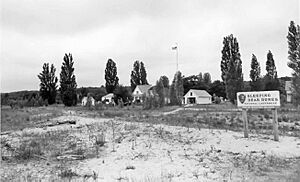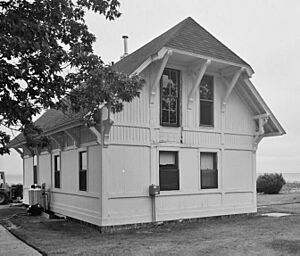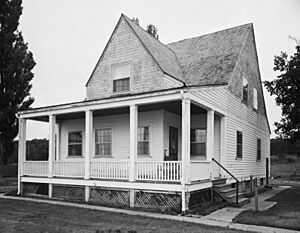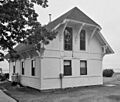North Manitou Island Lifesaving Station facts for kids
|
North Manitou Island Lifesaving Station
|
|
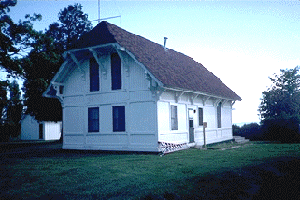
Undated National Park Service photo
|
|
| Location | East Coast, North Manitou Island, Sleeping Bear Dunes National Lakeshore, Michigan |
|---|---|
| Area | 3 acres (1.2 ha) |
| Built | 1854 |
| Architect | Francis W. Chandler, Albert B. Bibb |
| Architectural style | Gothic Revival, Queen Anne, Stick/Eastlake |
| NRHP reference No. | 98001191 |
Quick facts for kids Significant dates |
|
| Added to NRHP | August 5, 1998 |
| Designated NHLD | August 6, 1998 |
The North Manitou Island Lifesaving Station is a group of buildings on North Manitou Island in Michigan. This island is part of the Sleeping Bear Dunes National Lakeshore. The station was built to help save lives at sea. It is special because it was used during all three main periods of lifesaving history. This includes the early volunteer days, the time of the United States Life-Saving Service, and the United States Coast Guard. In 1998, it was named a National Historic Landmark.
History of the Lifesaving Station
In 1854, the United States government set aside money. This money was used to create volunteer life-saving stations on the Great Lakes. The North Manitou Island Lifesaving Station was one of these stations. Nicholas Pickard, who lived on the island, asked for a lifesaving boat. He also received plans to build the station. The boathouse on North Manitou Island is the only one left from those 1854 plans.
The Life-Saving Service Takes Over
The United States Life-Saving Service started in 1871. This meant that volunteer stations now had paid crews. In 1874, this service took over the North Manitou Island station. A new station was built in 1877. A paid crew began working there the next year. At first, the crew stayed with local people. But in 1887, a building for the crew was added to the station. More buildings were added over time as they were needed.
From Coast Guard to Park Service
The Life-Saving Service joined the United States Coast Guard in 1915. The Coast Guard ran the station until 1932. They decided the station was no longer needed because it didn't have a safe place to launch boats. The station kept a small crew until 1938. Then, it was sold to a private company called the Manitou Island Association. This company used the buildings for its workers. They also used them for their island hunting area. The National Park Service bought the station in 1984.
Buildings at the Station
The North Manitou Island Lifesaving Station has many buildings. They are on 3 acres (1.2 ha) of land on the northeast shore of North Manitou Island. The buildings were built between 1854 and about 1916. They show different building styles from history. They also represent the three main periods of lifesaving work.
The Lifesaving Station is on a flat area facing a sandy beach. It is near a grassy field. An access road runs close by. Many buildings were built here over the years. Some have been moved or torn down. The buildings that are still there include:
Volunteer Rescue Station (1854)
The Volunteer Rescue Station is a boathouse made of wood. It is about 17 feet (5.2 m) wide and 36 feet (11 m) long. The first floor had one large room for the surfboat. A small area above was used to store other gear. This building has been fixed to look like it did when it was new.
U.S. Life Boat Station (1877)
The U.S. Life Boat Station was built using a changed design from 1876. It has two stories and a special roof shape. This roof created a balcony for a lookout. The building has vertical wood siding. The Manitou Island Association later changed it into living quarters and a storage area. In 1990, the Sleeping Bear Dunes National Lakeshore turned it into a dormitory.
U.S. Life-Saving Service Dwelling (1887)
This building was likely designed by Albert B. Bibb. It is thought to be the only one of its kind in the country. It has two stories with cross-gables. The captain lived on the first floor. The crew lived on the second floor. In 1932, the Coast Guard updated the building. They added a basement and a front porch. In 1992, the Park Service changed the building to house its staff.
Hans Halseth House (1890s)
The Hans Halseth House was first located north of the station. It was moved to its current spot in 1912. The house has 1 1/2 stories with a gabled roof. It has been changed several times. This includes adding a front porch and two side additions. In 1990, the Park Service fixed up this building. They now use it to house employees.
Storm Tower and Flag Locker (around 1905)
The storm tower is a metal structure with four sides. It tapers to a point 50 feet (15 m) above the ground. A 20 feet (6.1 m) tall pole with sidearms sticks up from the top. An American flag flew from the top. Storm flags were flown from the sidearms. Flags were kept in a metal box at the bottom of the tower.
Images for kids




